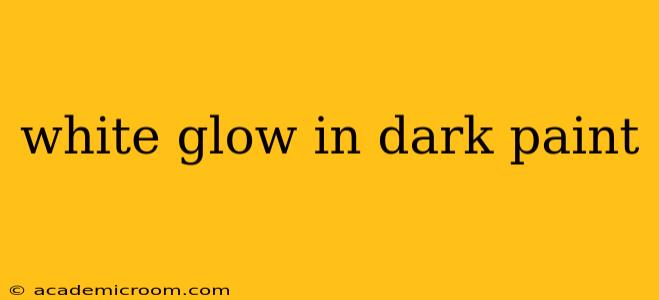Glow-in-the-dark paint has become increasingly popular for creative projects, home décor, and safety applications. While many associate glow paint with vibrant colors, achieving a bright white glow presents unique challenges. This comprehensive guide explores the science behind white glow-in-the-dark paint, its applications, and how to maximize its luminous effect.
What Makes Glow-in-the-Dark Paint Glow?
Glow-in-the-dark paint, also known as phosphorescent paint, contains phosphors – special crystals that absorb energy from a light source (like sunlight or UV light) and then slowly release it as light over time. This process is called phosphorescence. The brighter the charging light, and the longer the charging period, the brighter and longer the paint will glow. The color of the glow is dependent on the specific phosphor used. Achieving a bright white glow requires a blend of phosphors emitting different wavelengths of light, which is why it's a more complex process than creating glow-in-the-dark paint in other colors.
Why is Bright White Glow-in-the-Dark Paint Difficult to Achieve?
Creating a truly bright white glow is difficult because white light is comprised of all the colors of the visible spectrum. Individual phosphors typically emit light in a narrow range of wavelengths (resulting in colors like green, blue, or yellow). To create white, manufacturers need to carefully combine multiple phosphors that, when mixed, produce a balanced white glow. This requires precision and advanced technology. The intensity of the individual phosphors also plays a crucial role in the overall brightness of the white glow. A less intense blend will result in a fainter glow.
How Long Does White Glow-in-the-Dark Paint Glow?
The duration of the glow depends on several factors including:
- The type of phosphors used: Some phosphors are brighter but have a shorter glow duration, while others offer a longer but less intense glow.
- The intensity of the charging light: Brighter charging light results in a brighter and longer glow.
- The charging time: Longer charging periods increase glow duration and intensity.
- Environmental factors: Temperature and humidity can affect the glow duration.
Generally, high-quality white glow-in-the-dark paint can glow for several hours after being fully charged. However, the intensity will gradually decrease over time.
What are the Applications of White Glow-in-the-Dark Paint?
While often overlooked, white glow-in-the-dark paint has numerous applications:
- Safety markings: Creating subtle yet visible safety markings in dark environments. Think of hallways, stairwells, or emergency exits.
- Artistic expression: Adding a unique element to paintings, sculptures, or other artwork.
- Home décor: Enhancing the ambiance of a room with subtle, glowing accents.
- DIY projects: Used in crafting, model making, and other creative projects.
- Stars on ceilings: Creating a starry night effect on ceilings.
Is White Glow-in-the-Dark Paint Toxic?
The toxicity of glow-in-the-dark paint depends on the specific formulation. Some paints use non-toxic materials, while others may contain compounds that require caution. Always check the product label for safety information and follow the manufacturer's instructions for safe handling and application. Proper ventilation is usually recommended during application.
How Can I Maximize the Glow of My White Glow-in-the-Dark Paint?
To achieve the best results with your white glow-in-the-dark paint:
- Use a strong light source for charging: Direct sunlight, UV lights, or bright indoor lighting are ideal.
- Charge the paint for an extended period: Allow sufficient time for the phosphors to absorb enough energy.
- Apply multiple coats: Multiple thin coats generally give a better glow than one thick coat.
- Apply to a dark surface: A dark background will enhance the visibility of the glow.
- Use a high-quality paint: Choose reputable brands known for their bright and long-lasting glow.
Where Can I Buy White Glow-in-the-Dark Paint?
White glow-in-the-dark paint can be purchased from various online retailers and craft stores. Check online marketplaces or visit local stores that specialize in art supplies or home improvement materials. Remember to read reviews before purchasing to ensure quality and performance.
By understanding the science behind white glow-in-the-dark paint and following the tips provided, you can successfully incorporate this unique material into your next project. Remember to always prioritize safety and handle the paint responsibly.
